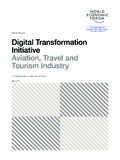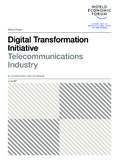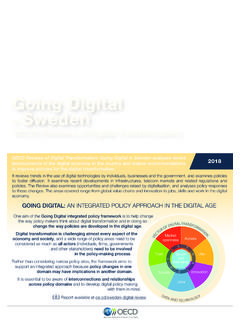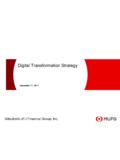Transcription of Digital transformation in insurance - EY
1 Digital transformation in insurance Creating value through Digital transformation For global insurers, Digital transformation and disruptive innovation have gone from being vague futuristic concepts to immediate-term action items on senior leaders' strategic agendas. New competitive threats, ongoing cost pressures, aging technology, increasing regulatory requirements and generally lackluster financial performance are among the forces that demand significant change and entirely new business models. Digital transformation in insurance : driving immediate value and enabling future innovation Other external developments the steady progress toward driverless cars, the rapid emergence of the Internet of Things (IoT) and profound demographic shifts are placing further pressure on insurers.
2 A common fear is that new market entrants will do to insurance what Uber has done to ride hailing, Amazon has done to retail and robo advisors are doing to investment and wealth management. Yes, Digital transformation has become an overused buzzword or equipped to move at the speed of Digital . Similarly, few, if any, beloved by industry analysts, consultants and pundits in the business insurers have the talent or workforce they need to thrive in the press. Yes, it can mean different things to different companies. industry's next era. However, it is true that nearly every insurer on the planet no Because the value proposition for Digital transformation programs matter its size, structure or particular circumstances should reaches every dimension of the business, it can drive breakthrough undertake Digital transformation immediately.
3 This is true because of performance both internally (through increased efficiency and ever-rising consumer expectations and the insurance sector's lagging process automation) and externally (through increased speed to position in terms of embracing Digital . market and richer consumer and agent experiences). Therefore, The good news is that many early adopters and fast followers have insurers must move boldly to devise enterprise-scale Digital already demonstrated the potential to generate value by embedding strategies (even if they are composed of many linked functional Digital capabilities deeply and directly into their business models.)
4 Processes and applications) and industrialize their Digital Even successful pilot programs have been of limited scope. By capabilities that is, deploy them at scale across the business. addressing narrowly defined problems or one specific part of the This paper will identify an actionable definition of Digital business, they have delivered limited value. Formidable cultural transformation and explore a range of specific use cases that can barriers also remain; most insurers are simply not accustomed produce the breakthrough performance gains and ROI insurers need. Early adopters and fast followers have generated value by embedding Digital capabilities deeply and directly into their business models.
5 Digital transformation in insurance : driving immediate value and enabling future innovation | 1. F rom core transformation to Digital transformation Recognizing the need to innovate and the limitations of existing One key challenge is the industry's lack of standardized technology, many insurers undertook core transformation methodologies and metrics to assess Digital maturity. With unclear programs. These investments were meant to help insurers set foot visibility, insurance leaders will have a difficult time knowing where into the Digital age, yet represented a very first step or foundation to prioritize investments or recognizing the most compelling parts so insurers could use basic Digital communications, paperless of the business case for Digital transformation .
6 Documents, online data entry, mobile apps and the like. These were necessary steps, as the latest EY insurance consumer research But, because Digital transformation is a long and continuous shows that more than 80% of customers are willing to use Digital journey, most insurers are best served by a phased or progressive and remote contact channels (including web chat, email, mobile approach. This is not to suggest that culturally risk-averse insurers apps, video or phone) in place of interacting with insurers via adopt even more caution. Rather, it is to acknowledge that agents or brokers. complete Digital transformation at one go can't be managed; there are simply too many contingencies, interdependencies and risks More advanced technologies, which can enable major efficiency that must be accounted for.
7 Gains and cost improvements for basic service tasks, also require stronger and more flexible core systems. Chatbot technology, for Insurers must be focused and bold within their progressive instance, can deliver considerable value in stand-alone deployments approach to Digital transformation , as it is the way to generate ( , without being fully integrated with core claims platforms). quick wins and create near-term value that can be invested in the However, the full ROI cannot be achieved without such integration. next steps. Each step along the Digital maturity curve enables future gains. Rather than waiting to be passively disrupted, truly For many insurers, core transformation programs are still Digital insurers move boldly and proactively, testing and learning underway, even as they recognize a clear need to do more.
8 In pursuit of innovation, and redesigning operations, engaging Linking Digital transformation programs to core transformation customers in new ways and seeking out new partners. (See Figure 1.). can help insurers use resources more effectively and strengthen the business case. Waiting for core transformation programs to be completed and then taking up the Digital transformation would likely result in many missed performance improvement and innovation opportunities, as well as higher implementation costs. Achieving the full value of Digital transformation req uires core transformation . Digital transformation in insurance : driving immediate value and enabling future innovation | 2.
9 Defining our terms: what Digital transformation means Digital transformation is a term used so frequently and variously that it is commonly misunderstood. The term is best defined as capitalizing on the power of technology to revisit business models, acquire customers to new channels and create essential user experiences. Insurers that digitize the enterprise in this way can automate slow, error-prone and expensive processes for increased speed, accuracy and cost efficiency. They can streamline and simplify existing operations to deliver immediate-term performance gains, but also to become more nimble for longer-term success, based on a well-honed ability to continuously add and enhance more Digital capabilities.
10 By definition, Digital transformation strategies can be applied broadly across the organization and incorporate a number of related disciplines. Innovation management: Insurers today must offer a wider portfolio of products for them to stay relevant to consumers looking for high degrees of personalization. Innovative portfolio management techniques and the ability to establish product factories are critical to designing better products and delivering them to market faster. Innovation isn't just about products, of course. Digital transformation programs may drive innovation in back-office processes, too (fully automated claims management processes, etc.)













